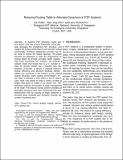| dc.contributor.author | Fang, Hui | |
| dc.contributor.author | Hsu, Wen Jing | |
| dc.contributor.author | Rudolph, Larry | |
| dc.date.accessioned | 2005-12-14T19:45:27Z | |
| dc.date.available | 2005-12-14T19:45:27Z | |
| dc.date.issued | 2006-01 | |
| dc.identifier.uri | http://hdl.handle.net/1721.1/30294 | |
| dc.description.abstract | In dynamic P2P networks, nodes join and depart from the system frequently, which partially damages the predefined P2P structure, and impairs the system performance such as basic lookup functionality. Therefore stabilization process has to be done to restore the logical topology. This paper presents an approach to relax the requirement on routing tables to provide provably better stability than fixed structured P2P systems. We propose a relaxed Chord that keeps the O(logN) number of hops for greedy lookup, but it requires less stabilization overhead. It allows a tradeoff between lookup efficiency and structure flexibility without adding any overhead to the system. In the relaxed routing structure, each routing entry ("finger") of the node is allowed to vary within a set of values. Each node only needs to keep a certain number of fingers that point to nodes in its anchor set. This relaxation reduces the burden of state management of the node. The relaxed routing scheme provides an alternative structure other than randomized P2P and deterministic P2P, by relaxing on finger selection. It provides good flexibility and therefore extends the system functioning time. | en |
| dc.description.sponsorship | Singapore-MIT Alliance (SMA) | en |
| dc.format.extent | 85408 bytes | |
| dc.format.mimetype | application/pdf | |
| dc.language.iso | en | en |
| dc.relation.ispartofseries | Computer Science (CS) | en |
| dc.subject | P2P | en |
| dc.subject | chord | en |
| dc.subject | greedy routing | en |
| dc.subject | relaxed DHT | en |
| dc.subject | anchor set | en |
| dc.title | Relaxing Routing Table to Alleviate Dynamism in P2P Systems | en |
| dc.type | Article | en |
